The exercise bike is legitimately one of the most practical pieces of fitness equipment in existence. The best exercise bikes takes the outdoor bike — one of the most useful devices for maximizing the distance we can travel as a human being on our own steam — and adapts it for fitness use. On the basis of childhood nostalgia plus efficiency alone, it makes sense to invite an exercise bike into your home gym.
The thing is, there are so many types of exercise bikes, with different configurations and features that align with different fitness goals. You might want a bike that replicates the feel of a spin class into your living room, or one that allows you to adopt a relaxed position while you press the pedals. Either way, our handy exercise bike buying guide will help you make a well-informed purchase decision that will meet all your fitness needs.
Types of Exercise Bikes
The good news is that you can elevate your heart rate, burn some calories, and get a functional cardio workout no matter what type of exercise bike you buy. It’s when your needs extend beyond basic cardiovascular requirements that the type of bike you choose to ride really becomes an influential factor.
One of our BarBend equipment experts, Amanda Capritto, CPT, CNSC, knows the ins and outs of exercise bikes. You can use her insights to assist you as you select the riding experience that is most conducive to fulfilling all of your fitness needs.
Recumbent Bike
The best recumbent bikes offer their users a reclined seating position and handlebars that are off to the sides of the seat instead of on the center console. These bikes are usually also lower to the ground, making them easier to get on and off than other, higher bikes. This feature also makes them excellent options for beginners or people rehabbing injuries who wish to enjoy bike workouts with minimal difficulty.
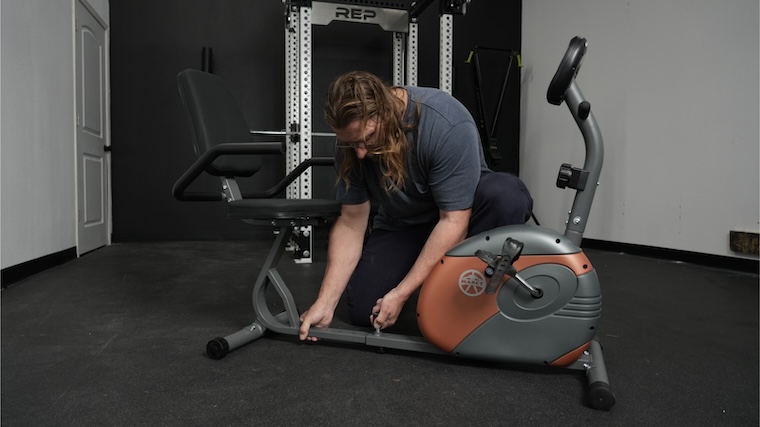
“Recumbent bikes allow people with mobility limitations or injuries to enjoy cycling, as they are reclined and take pressure off of the hips and back,” says Capritto. “Older adults and individuals with limited mobility may struggle to get on and off of an exercise bike, in which case a recumbent bike is recommended.”
Upright Bike
The objective of an upright bike is to give your body more of a vertical orientation. To accomplish this, both the padded saddle and the handlebars will be in a higher position than on most exercise bikes, and with the handlebars significantly higher than the seat. This places your body in a comfortable seating position while eliminating your ability to stand upright, helping your back to stay vertical.

“Upright bikes are your typical stationary bikes, which are excellent for high-intensity exercise and tech-savvy cyclists who love to take fitness classes,” explains Capritto.
Indoor Cycling Bikes
The indoor cycling bike is the model that nearly all cycling classes — including spin classes — are built around. It’s also the bike that comes the closest to mimicking an outdoor bike, as it places you in the same posture of a competitive cyclist. These are the bikes most likely to come pre-stocked with instructor-led workouts, which is also why several models include dumbbells for simultaneous strength training.
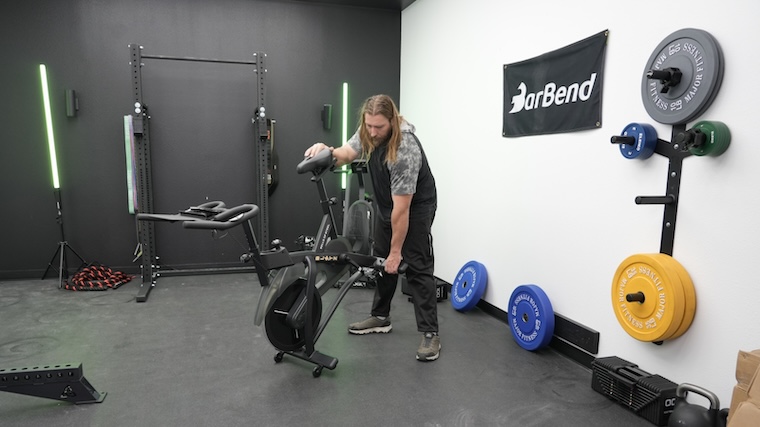
Air Bikes
The air bike is the exercise bike most likely to make you nauseous mid-workout. While nearly every other type of bike resembles an outdoor bike that could actually be used to get somewhere, air bikes provide resistance arms that allow you to simultaneously train your upper and lower body against air resistance. This makes air bikes a favorite amongst CrossFitters and HIIT (high-intensity interval training) enthusiasts who wish to include total-body sprint work in their workout routines.

Folding Bikes
The best folding exercise bikes take on the basic form and function of an ordinary stationary exercise bike, except it is usually stripped down to make it foldable and easy to store. This makes it a popular bike model if space is at a premium, and you need to move the bike out of the way once you’ve finished using it.
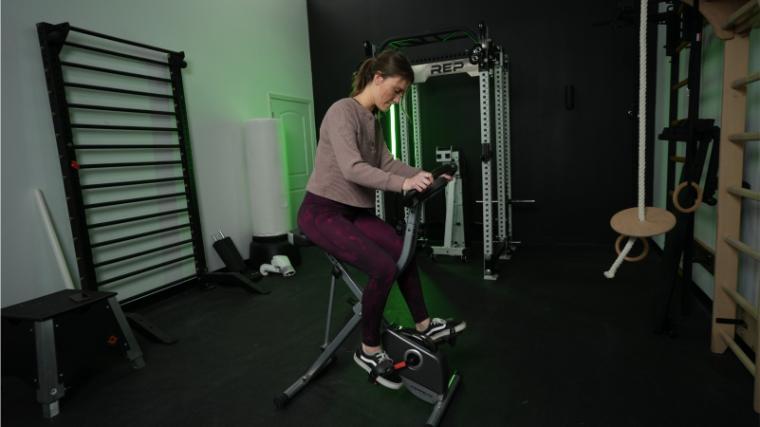
How to Choose an Exercise Bike
When the time comes to choose an exercise bike, it usually isn’t as simple as simply swiping your credit card for the bike with the most features. Even if you only care about the benefits of cycling and don’t stress over technical elements, there are still a lot of factors that you might want to at least consider before making a final purchase.
Price
Much of the difference between moderately priced and high-priced bikes is reflected in the manufacturer’s brand name, and also in the advanced technological features. Be mindful of how much certain features are worth to you, because they can be the primary factor in determining whether you spend $500 or $1,500 for a bike that has the same basic form and function.
Availability
With so many specialty bikes being in high demand — especially during the holiday season — it can be difficult to guarantee the availability of every bike you want. However, if you’re not wedded to a specific brand of elite bike, there are plenty of bikes in every category that match the functionality of what you’re looking for in your workout, only without the interactive screens and varying scenery.
Environmental Impact & Labor Practices
Since most exercise bikes are powered manually, the majority of them require far less electricity than a treadmill or an elliptical might. Air bikes in particular are similar to a rowing machine or a manual treadmill in the sense that it is powered entirely through a resistance system that harnesses the efforts of its users.
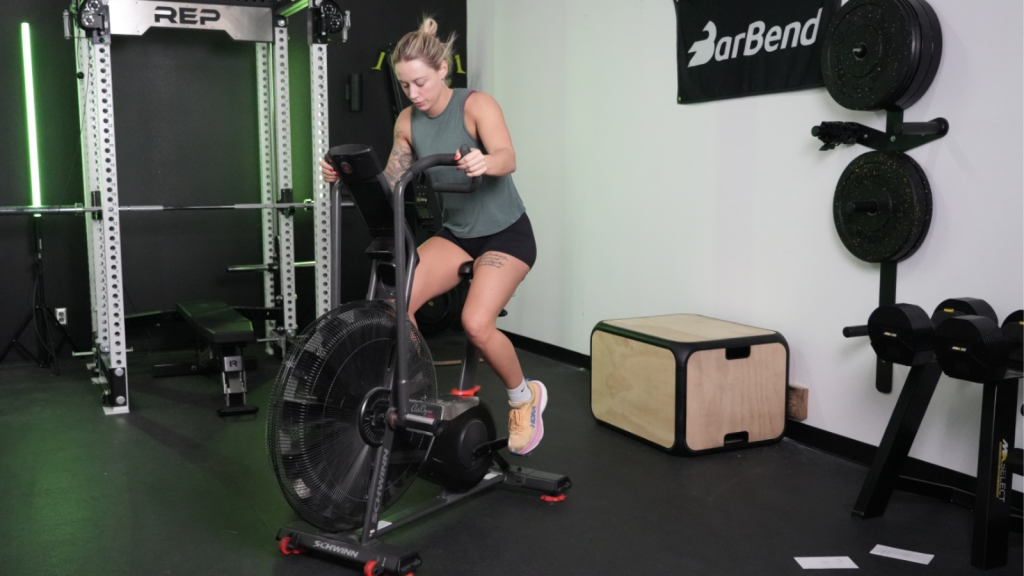
“Air bikes are powered by the user, with a fan flywheel that creates resistance,” explains Capritto. That means that if you’re looking for a relatively green machine (environmentally speaking), bikes that power themselves may be your cup of tea. Buying used machines can lessen the environmental impact of your purchase even more. You may also want to look into the labor practices of the brands you’re considering.
Adjustability
It goes without saying that not everyone has the same body type and physical dimensions, which automatically means that exercise bikes are not one-size-fits-all models. This is why it can be beneficial to have a bike that is adjustable in multiple ways. You’ll want an adjustable seat, adaptable resistance levels, and other change capabilities that can be made for the sake of ergonomic improvements.
Warranty
No matter how good of a deal you receive on your bike, it won’t seem like a wise investment if the bike breaks down on you right away. Many bikes bought new are governed by warranty policies that have different time windows for repairs and replacements on different parts of the bike. This is why it’s helpful to pay close attention to how long the different pieces of your bike will remain under warranty.

“Definitely review maintenance requirements before purchasing any type of exercise bike, as well as warranty,” advises Capritto. “Look for at least 5 years on the frame, 2 years on parts, and 1 year for labor.”
Resistance
Bikes can have drastically different forms of resistance, with the most common being friction resistance, magnetic resistance, and flywheel resistance. Far from being minor distinctions, the type of resistance your bike utilizes can be more important than the configuration of the bike itself as far as contributing to the feel of the workout. You should definitely select a resistance type that you don’t mind pedaling through for multiple hours every week.
Programming & Tech
A lot of the value differentiation between bikes is determined by the programs and technology they either include or support. This can range from a heart rate monitor embedded in the handlebar to large touchscreens that support cycling apps that deliver instructor-led workouts. If you think you’ll lack the motivation to bike without the influence of a personal trainer, you’ll certainly want a bike that avails you of that option.
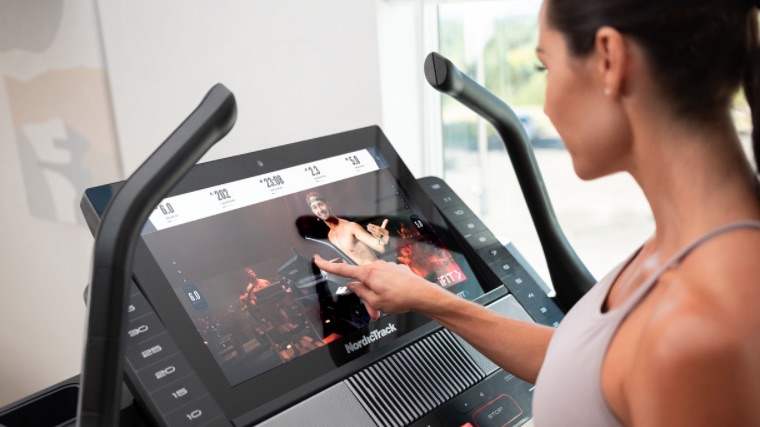
“For [exercise] bikes, you’ll notice that there are two distinct camps: Those without giant touchscreen displays, and those with them,” says Capritto. “Peloton-esque bikes have become ultra-popular among people who love the fitness studio vibes that come from interactive workout sessions, both live and pre-recorded. If this is something you’re interested in, be prepared to shell out a significant amount of cash and also pay for a monthly subscription. Budget-friendly options are available, but comparatively lack in the tech department.”
[Related: Peloton vs NordicTrack]
Flywheel
The flywheel sits at either the front or rear of the bike, and the weight of the flywheel and nature of the drive system is what prompts its movement determines how challenging your workout is. Most flywheels fall within a range of 8 to 40 pounds. Meanwhile, the flywheel will be driven by either a belt drive or a chain drive, with belt drives being smoother, and chain drives equating to the driving mechanism found on more outdoor bikes.
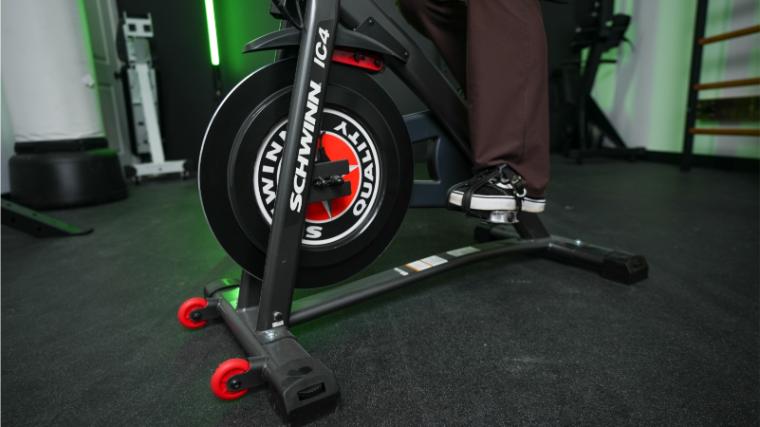
“As for air bikes, the most important spec in my opinion is the drive,” explains Capritto. “Is it a belt drive or a chain drive? Belt drives (found on the Rogue Echo Bike) are more durable and don’t require as much or as frequent maintenance as chain drives (found on Assault AirBikes).”
Pedals
While flat bike pedals are very straightforward, there are also toe cages and toe straps that enable your bike to respond when your feet move both up and down. Also, if your bike is a spin-style bike, it likely comes with clip-in pedals, which are either Look Delta or SPD — labels that correspond to the type of cleated shoe you’re wearing. Fortunately, if you decide that you’re not a fan of the pedal style your bike comes with, they are usually replaceable.
Saddle
Bike seats — also known as saddles — are not one-size-fits-all devices. The cushioning thickness and distribution can vary from seat to seat. You may want to test different sizes, padding styles, and padding configurations to determine which saddle you like the best. Fortunately, as with pedals, most saddles are replaceable, so you should be able to customize your bike with the saddle type you like the most.
Brand
The brand of a bike can factor immensely in your decision of which bike to purchase. Some bike brands — like Schwinn — offer everything from kids bikes all the way to specialty indoor models like the Schwinn 230 recumbent bike.
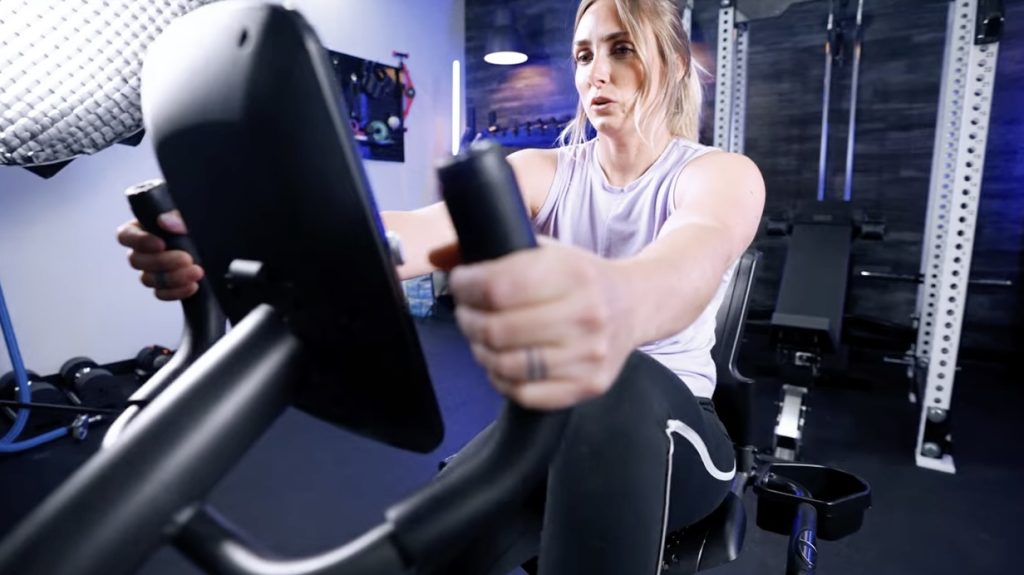
Other brands, like NordicTrack and Bowflex, exclusively make specialized indoor bikes. Because of the exclusivity that some brands have with patented features and options, the bike’s brand may be critically important to you.
How to Find an Exercise Bike Based on Your Goals
The type of bike you choose is going to depend on your own needs, not some universal standard. This means two exercisers in different stages of life may make totally different demands of an exercise bike. Here, we’ll cut to the chase and identify the best biking options based on your personal preferences.
Best Exercise Bike for HIIT
All things considered, what makes a bike optimal for high intensity workouts is its ability to be responsive to rapid shifts in speed while engaging as many of your muscles as possible. While some bikes will intentionally isolate your legs to maximize rider comfort, there are a few that go out of their way to challenge multiple muscle groups — aka, the air bike, which will have you huffing and puffing in absolutely no time.
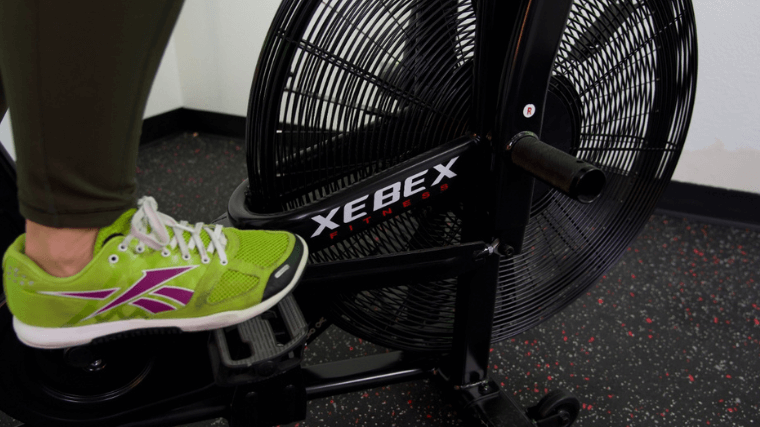
The Winner: Air Bike
The Runner-Up: Indoor Bike
Best Exercise Bike for Weight Loss
The best bike for weight loss is going to be the bike that involves as many of your muscle groups as possible in a way that allows you to burn the most calories. Some consideration must also be given to the time window that an average person is going to have for squeezing in a workout. Once again, the air bike slides into the top slot here because of the way it uses your entire body. Can’t handle that intensity? No problem. The indoor bike does great, too.
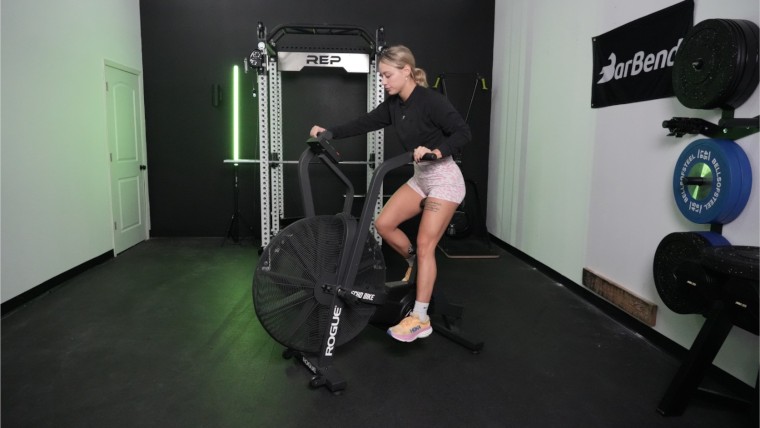
The Winner: Air Bike
The Runner-Up: Indoor Bike
Best Exercise Bike for Low-Impact Workouts and Recovery
If you’re looking for a low-impact workout that minimizes the potential for injury, reinjury, or stress of any kind, you have specific needs for a bike. These needs include the capacity to elevate your heart rate while removing as much strain as possible from your workout. In this case, bikes that force you to use several muscle groups and support your own body weight are doing you no favors. Instead, the recumbent bike rises to the top here.
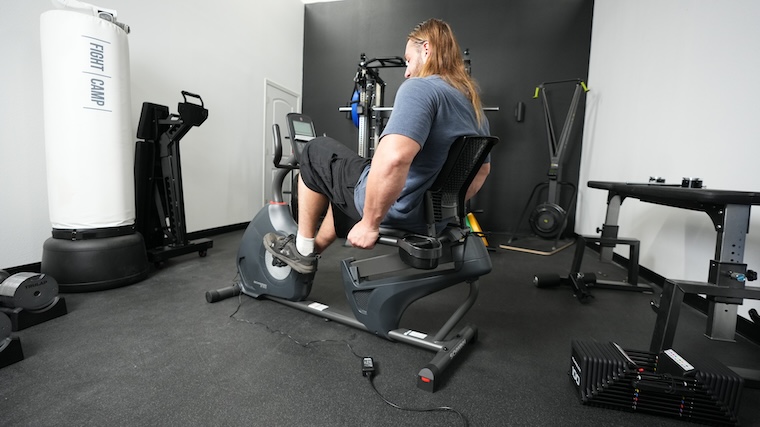
The Winner: Recumbent Bike
The Runner-Up: Upright Bike
Best Exercise Bike for Home Gyms
Selecting the best bike in general for a home gym can be a tricky proposition, because different home gyms prioritize different bike characteristics. For instance, if your foremost desire is to replicate an outdoor cycling experience at home with instructor-led workouts , you’ll prioritize indoor bikes like the Stryde Bike that can deliver that feeling. Then again, if your space is limited, the ability to conserve space may trump all other desires.
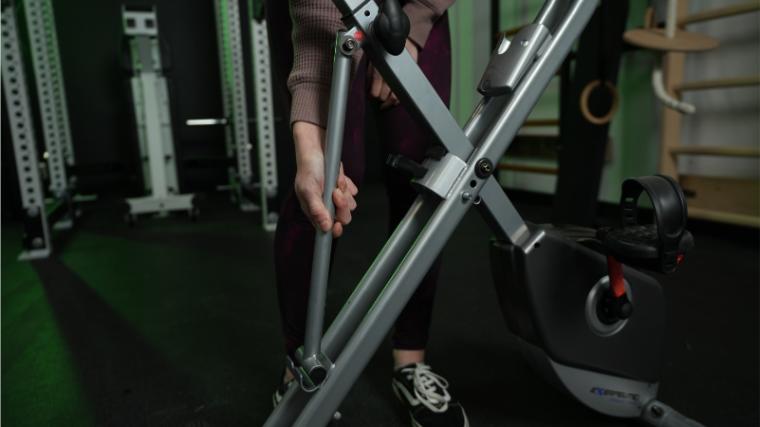
The Winner: Folding Bike
The Runner-Up: Indoor Bike
Exercise Bike Buying Guide FAQs
Who can use exercise bikes?
Aside from some athletes with low to no mobility in their lower body, very many people can benefit from an exercise bike. Recumbent bikes are particularly accessible to people across many body types, injury statuses, and ability levels.
How much is a stationary bike?
Stationary bikes can range in price from $150 to upwards of $3,000. Many factors will weigh on the ultimate price of the bike, including its brand, functionality, adjustability, storability, and technological attributes.
What type of exercise bike is best?
There’s an argument to be made that the best exercise bikes are the bikes that fulfill all of your workout requirements for the lowest price. However, personal workout requirements will vary widely. For example, some people will prefer an air bike — which is not modeled from a steerable outdoor model — because of its usefulness in HIIT workouts. On the other hand, if you prioritize space conservation, a compact, foldable bike might be ideal for your situation.
What is the warranty on an exercise bike?
Warranties on exercise bikes nearly always fall within a range of 1 year to a lifetime, with different warranties often provided on different parts of the bike. Our expert’s recommendation is that you find a bike with a frame warranty of at least 5 years, a parts warranty of at least 2 years, and a labor warranty of at least 1 year.
What should I look for when purchasing an exercise bike?
Once you’ve made up your mind that an exercise bike suits your needs, you should find the bike that will fill as many of your workout requirements as possible while remaining within your budget. Consider everything from price and brand to tech features, resistance type, adjustability, and flywheel type.
References
- Said CM, Delahunt M, Hardidge A, Smith P, Tran P, McDonald L, Kefalianos E, Daniel C, Berney S. Recumbent cycling to improve outcomes in people with hip fracture: a feasibility randomized trial. BMC Geriatr. 2021 Jun 29;21(1):394. doi: 10.1186/s12877-021-02321-8. PMID: 34187387; PMCID: PMC8244148.
- Brand A, Sepp T, Klöpfer-Krämer I, Müßig JA, Kröger I, Wackerle H, Augat P. Upper Body Posture and Muscle Activation in Recreational Cyclists: Immediate Effects of Variable Cycling Setups. Res Q Exerc Sport. 2020 Jun;91(2):298-308. doi: 10.1080/02701367.2019.1665620. Epub 2019 Nov 13. PMID: 31718522.
- Moghaddam M, Cervantes M, Cheshier B, Jacobson BH. Sprint Interval Training on Stationary Air Bike Elicits Cardiorespiratory Adaptations While Being Time-Efficient. J Strength Cond Res. 2023 Sep 1;37(9):1795-1801. doi: 10.1519/JSC.0000000000004483. PMID: 37616537.